Body Composition and Fitness Characteristics of Firefighters Participating in a Health and Wellness Program: Relationships and Descriptive Data
Abstract
1. Introduction
2. Materials and Methods
2.1. Subjects
2.2. Procedures
2.3. Height, Body Mass, Body Mass Index (BMI), Body Fat Percentage (BF%)
2.4. Waist Circumference (WC) and Waist-to-Hip Ratio (WHR)
2.5. Sit-and-Reach
2.6. Grip Strength
2.7. Leg Press
2.8. Abdominal Crunches
2.9. Push-ups
2.10. Estimated Maximal Aerobic Capacity (V̇O2max)
2.11. Statistical Analysis
3. Results
4. Discussion
5. Conclusions
Author Contributions
Funding
Institutional Review Board Statement
Informed Consent Statement
Data Availability Statement
Conflicts of Interest
References
- Walker, A.; Pope, R.; Schram, B.; Gorey, R.; Orr, R. The Impact of Occupational Tasks on Firefighter Hydration During a Live Structural Fire. Safety 2019, 5, 36. [Google Scholar] [CrossRef]
- Guidotti, T.L.; Clough, V.M. Occupational health concerns of firefighting. Annu Rev Public Health 1992, 13, 151–171. [Google Scholar] [CrossRef] [PubMed]
- Melius, J. Occupational health for firefighters. Occup. Med. 2001, 16, 101–108. [Google Scholar] [PubMed]
- Kesler, R.M.; Mayer, A.; Fent, K.W.; Chen, I.-C.; Deaton, A.S.; Ormond, R.B.; Smith, D.L.; Wilkinson, A.; Kerber, S.; Horn, G.P. Effects of firefighting hood design, laundering and doffing on smoke protection, heat stress and wearability. Ergonomics 2021, 64, 755–767. [Google Scholar] [CrossRef] [PubMed]
- Carlton, S.D.; Orr, R.M. The Impact of Occupational Load Carriage on Carrier Mobility: A Critical Review of the Literature. Int. J. Occup. Saf. Ergon. 2014, 20, 33–41. [Google Scholar] [CrossRef] [PubMed]
- Lesniak, A.Y.; Bergstrom, H.C.; Clasey, J.L.; Stromberg, A.J.; Abel, M.G. The Effect of Personal Protective Equipment on Firefighter Occupational Performance. J. Strength Cond. Res. 2020, 34, 2165–2172. [Google Scholar] [CrossRef] [PubMed]
- Rhea, M.R.; Alvar, B.A.; Gray, R. Physical fitness and job performance of firefighters. J. Strength Cond. Res. 2004, 18, 348–352. [Google Scholar] [CrossRef] [PubMed]
- Gledhill, N.; Jamnik, V.K. Characterization of the physical demands of firefighting. Can. J. Sport Sci 1992, 17, 207–213. [Google Scholar]
- A Michaelides, M.; Parpa, K.M.; Henry, L.J.; Thompson, G.B.; Brown, B.S. Assessment of Physical Fitness Aspects and Their Relationship to Firefighters’ Job Abilities. J. Strength Cond. Res. 2011, 25, 956–965. [Google Scholar] [CrossRef]
- Sheaff, A.K.; Bennett, A.; Hanson, E.D.; Kim, Y.-S.; Hsu, J.; Shim, J.K.; Edwards, S.T.; Hurley, B.F. Physiological Determinants of the Candidate Physical Ability Test in Firefighters. J. Strength Cond. Res. 2010, 24, 3112–3122. [Google Scholar] [CrossRef]
- Williams-Bell, F.M.; Villar, R.; Sharratt, M.T.; Hughson, R.L. Physiological Demands of the Firefighter Candidate Physical Ability Test. Med. Sci. Sport. Exerc. 2009, 41, 653–662. [Google Scholar] [CrossRef] [PubMed]
- Skinner, T.L.; Kelly, V.G.; Boytar, A.N.; Peeters, G.; Rynne, S.B. Aviation Rescue Firefighters physical fitness and predictors of task performance. J. Sci. Med. Sport 2020, 23, 1228–1233. [Google Scholar] [CrossRef] [PubMed]
- Baur, D.M.; Christophi, C.A.; Tsismenakis, T.; Cook, E.F.; Kales, S.N. Cardiorespiratory Fitness Predicts Cardiovascular Risk Profiles in Career Firefighters. J. Occup. Environ. Med. 2011, 53, 1155–1160. [Google Scholar] [CrossRef]
- Martin, Z.T.; Schlaff, R.A.; Hemenway, J.K.; Coulter, J.R.; Knous, J.L.; Lowry, J.E.; Ode, J.J. Cardiovascular Disease Risk Factors and Physical Fitness in Volunteer Firefighters. Int. J. Exerc. Sci. 2019, 12, 764–776. [Google Scholar] [PubMed]
- Soteriades, E.S.; Hauser, R.; Kawachi, I.; Liarokapis, D.; Christiani, D.C.; Kales, S.N. Obesity and Cardiovascular Disease Risk Factors in Firefighters: A Prospective Cohort Study. Obes. Res. 2005, 13, 1756–1763. [Google Scholar] [CrossRef] [PubMed]
- Soteriades, E.S.; Smith, D.L.; Tsismenakis, A.J.; Baur, D.M.; Kales, S.N. Cardiovascular disease in US firefighters: A systematic review. Cardiol. Rev. 2011, 19, 202–215. [Google Scholar] [CrossRef] [PubMed]
- Barros, B.; Oliveira, M.; Morais, S. Firefighters’ occupational exposure: Contribution from biomarkers of effect to assess health risks. Environ. Int. 2021, 156, 106704. [Google Scholar] [CrossRef]
- Smith, D.L.; Deblois, J.P.; Kales, S.N.; Horn, G.P. Cardiovascular Strain of Firefighting and the Risk of Sudden Cardiac Events. Exerc. Sport Sci. Rev. 2016, 44, 90–97. [Google Scholar] [CrossRef]
- Cornell, D.J.; Gnacinski, S.L.; Meyer, B.B.; Ebersole, K.T. Changes in health and fitness in firefighter recruits: An observational cohort study. Med. Sci. Sport. Exerc. 2017, 49, 2223–2233. [Google Scholar] [CrossRef]
- Cameron, N.A.; Shen, J.; Rusk, K.; Parker, R.; Godino, J.G.; Nichols, J.F. Longitudinal Decline in Cardiorespiratory Fitness With Age Among Male Firefighters in San Diego, California, 2005–2015. Am. J. Public Health 2018, 108, 1388–1393. [Google Scholar] [CrossRef]
- Dobson, M.; Choi, B.; Schnall, P.L.; Wigger, E.; Garcia-Rivas, J.; Israel, L.; Baker, D.B. Exploring Occupational and Health Behavioral Causes of Firefighter Obesity: A Qualitative Study. Am. J. Ind. Med. 2013, 56, 776–790. [Google Scholar] [CrossRef] [PubMed]
- Lockie, R.G.; Orr, R.M.; Dawes, J.J. Fit (and Healthy) for Duty: Blood Lipid Profiles and Physical Fitness Test Relationships from Police Officers in a Health and Wellness Program. Int. J. Environ. Res. Public Health 2022, 19, 5408. [Google Scholar] [CrossRef] [PubMed]
- Kuehl, H.; Mabry, L.; Elliot, D.L.; Kuehl, K.S.; Favorite, K.C. Factors in adoption of a fire department wellness program: Champ-and-chief model. J. Occup. Environ. Med. 2013, 55, 424–429. [Google Scholar] [CrossRef] [PubMed]
- Lockie, R.G.; Orr, R.M.; Dawes, J.J. Slowing the Path of Time: Age-Related and Normative Fitness Testing Data for Police Officers From a Health and Wellness Program. J. Strength Cond. Res. 2021, 36, 747–756. [Google Scholar] [CrossRef] [PubMed]
- Rachele, J.N.; Heesch, K.; Washington, T.L.S. Wellness Programs at Firefighter and Police Workplaces: A Systematic Review. Health Behav. Policy Rev. 2014, 1, 302–313. [Google Scholar] [CrossRef]
- MacMillan, F.; Kolt, G.S.; Le, A.; George, E.S. Systematic review of randomised control trial health promotion intervention studies in the fire services: Study characteristics, intervention design and impacts on health. Occup. Environ. Med. 2020, 78, 454–463. [Google Scholar] [CrossRef]
- Lockie, R.G.; Pope, R.P.; Saaroni, O.; Dulla, J.M.; Dawes, J.J.; Orr, R.M. Job-Specific Physical Fitness Changes Measured by the Work Sample Test Battery within Deputy Sheriffs between Training Academy and their First Patrol Assignment. Int. J. Exerc. Sci. 2020, 13, 1262–1274. [Google Scholar]
- Boyce, R.W.; Jones, G.R.; Schendt, K.E.; Lloyd, C.L.; Boone, E.L. Longitudinal Changes in Strength of Police Officers With Gender Comparisons. J. Strength Cond. Res. 2009, 23, 2411–2418. [Google Scholar] [CrossRef]
- Dawes, J.J.; dos Santos, M.L.; Kornhauser, C.; Holmes, R.J.; Alvar, B.A.; Lockie, R.G.; Orr, R.M. Longitudinal Changes in Health and Fitness Measures Among State Patrol Officers by Sex. J. Strength Cond. Res. 2022, in press. [Google Scholar] [CrossRef]
- Dalton, M.; Cameron, A.J.; Zimmet, P.Z.; Shaw, J.E.; Jolley, D.; Dunstan, D.W.; Welborn, T.A.; On behalf of the AusDiab steering committee. Waist circumference, waist–hip ratio and body mass index and their correlation with cardiovascular disease risk factors in Australian adults. J. Intern. Med. 2003, 254, 555–563. [Google Scholar] [CrossRef]
- De Koning, L.; Merchant, A.T.; Pogue, J.; Anand, S.S. Waist circumference and waist-to-hip ratio as predictors of cardiovascular events: Meta-regression analysis of prospective studies. Eur. Heart J. 2007, 28, 850–856. [Google Scholar] [CrossRef] [PubMed]
- Kaipust, C.M.; Jahnke, S.A.; Poston, W.S.; Jitnarin, N.; Haddock, C.K.; Delclos, G.L.; Day, R.S. Sleep, Obesity, and Injury Among US Male Career Firefighters. J. Occup. Environ. Med. 2019, 61, e150–e154. [Google Scholar] [CrossRef] [PubMed]
- Poston, W.S.C.; Haddock, C.K.; Jahnke, S.A.; Jitnarin, N.; Tuley, B.C.; Kales, S.N. The Prevalence of Overweight, Obesity, and Substandard Fitness in a Population-Based Firefighter Cohort. J. Occup. Environ. Med. 2011, 53, 266–273. [Google Scholar] [CrossRef] [PubMed]
- Lockie, R.G.; Orr, R.M.; Montes, F.; Ruvalcaba, T.J.; Dawes, J.J. Differences in Fitness between Firefighter Trainee Academy Classes and Normative Percentile Rankings. Sustainability 2022, 14, 6548. [Google Scholar] [CrossRef]
- U.S. Fire Administration. Emerging Health and Safety Issues among Women in the Fire Service. Available online: https://www.usfa.fema.gov/downloads/pdf/publications/emerging_health_safety_issues_women_fire_service.pdf (accessed on 4 March 2021).
- Dawes, J.J.; Orr, R.M.; Siekaniec, C.L.; Vanderwoude, A.A.; Pope, R. Associations between anthropometric characteristics and physical performance in male law enforcement officers: A retrospective cohort study. Ann. Occup. Environ. Med. 2016, 28, 26. [Google Scholar] [CrossRef]
- Lockie, R.G.; Carlock, B.N.; Ruvalcaba, T.J.; Dulla, J.M.; Orr, R.M.; Dawes, J.J.; McGuire, M.B. Skeletal Muscle Mass and Fat Mass Relationships With Physical Fitness Test Performance in Law Enforcement Recruits Before Academy. J. Strength Cond. Res. 2021, 35, 1287–1295. [Google Scholar] [CrossRef]
- Lockie, R.G.; Ruvalcaba, T.R.; Stierli, M.; Dulla, J.M.; Dawes, J.J.; Orr, R.M. Waist Circumference and Waist-to-Hip Ratio in Law Enforcement Agency Recruits: Relationship to Performance in Physical Fitness Tests. J. Strength Cond. Res. 2020, 34, 1666–1675. [Google Scholar] [CrossRef]
- Collins, K.S.; Christensen, B.; Orr, R.M.; Dulla, J.M.; Dawes, J.J.; Lockie, R.G. Analysis of total and segmental body composition relative to fitness performance measures in law enforcement recruits. Int. J. Exerc. Sci. 2022, 15, 245–260. [Google Scholar]
- Riebe, D.; Ehrman, J.K.; Liguori, G.; Magal, M. ACSM’s Guidelines for Exercise Testing and Prescription, 10th ed.; Wolters Kluwer: Philadelphia, PA, 2018. [Google Scholar]
- Ryan, E.D.; Cramer, J.T. Fitness Testing Protocols and Norms. In NSCA’s Essentials of Personal Training; Coburn, J.W., Malek, M.H., Eds.; Human Kinetics: Champaign, IL, USA, 2012; pp. 201–247. [Google Scholar]
- Lockie, R.G.; Rodas, K.A.; Dawes, J.J.; Dulla, J.M.; Orr, R.M.; Moreno, M.R. How does time spent working in custody influence health and fitness characteristics of law enforcement officers? Int. J. Environ. Res. Public Health 2021, 18, 9297. [Google Scholar] [CrossRef]
- Long Beach Firefighters Association. About Us. Available online: https://www.lbff.org/about-us/ (accessed on 16 November 2022).
- World Medical Association. World Medical Association Declaration of Helsinki. Recommendations guiding physicians in biomedical research involving human subjects. JAMA 1997, 277, 925–926. [Google Scholar] [CrossRef]
- Vasold, K.L.; Parks, A.C.; Phelan, D.M.; Pontifex, M.B.; Pivarnik, J.M. Reliability and Validity of Commercially Available Low-Cost Bioelectrical Impedance Analysis. Int. J. Sport Nutr. Exerc. Metab. 2019, 29, 406–410. [Google Scholar] [CrossRef] [PubMed]
- Reinert, B.L.; Pohlman, R.; Hartzler, L. Correlation of Air Displacement Plethysmography with Alternative Body Fat Measurement Techniques in Men and Women. Int. J. Exerc. Sci. 2012, 5, 367–378. [Google Scholar] [PubMed]
- Liemohn, W.; Sharpe, G.L.; Wasserman, J.F. Criterion related validity of the sit-and-reach test. J. Strength Cond Res. 1994, 8, 91–94. [Google Scholar]
- Lockie, R.G.; Schultz, A.B.; Callaghan, S.J.; Jordan, C.A.; Luczo, T.M.; Jeffriess, M.D. A preliminary investigation into the relationship between functional movement screen scores and athletic physical performance in female team sport athletes. Biol. Sport 2015, 32, 41–51. [Google Scholar] [CrossRef] [PubMed]
- Lockie, R.G.; Dawes, J.J.; Kornhauser, C.L.; Holmes, R.J. Cross-Sectional and Retrospective Cohort Analysis of the Effects of Age on Flexibility, Strength Endurance, Lower-Body Power, and Aerobic Fitness in Law Enforcement Officers. J. Strength Cond. Res. 2019, 33, 451–458. [Google Scholar] [CrossRef]
- Lockie, R.G.; Orr, R.M.; Stierli, M.; Cesario, K.A.; Moreno, M.R.; Bloodgood, A.M.; Dulla, J.M.; Dawes, J.J. Physical Characteristics by Sex and Age for Custody Assistants From a Law Enforcement Agency. J. Strength Cond. Res. 2019, 33, 2223–2232. [Google Scholar] [CrossRef]
- Su, C.-Y.; Lin, J.-H.; Chien, T.-H.; Cheng, K.-F.; Sung, Y.-T. Grip strength in different positions of elbow and shoulder. Arch. Phys. Med. Rehabil. 1994, 75, 812–815. [Google Scholar] [CrossRef]
- Misner, J.E.; Boileau, R.A.; Plowman, S.A.; Elmore, B.G.; Gates, M.A.; Gilbert, J.A.; Horswill, C. Leg Power Characteristics of Female Firefighter Applicants. J. Occup. Environ. Med. 1988, 30, 433–437. [Google Scholar] [CrossRef]
- National Fire Protection Association. NFPA 1582: Standard on Comprehensive Occupational Medical Program for Fire Departments. Available online: https://www.princegeorgescountymd.gov/DocumentCenter/View/25941/Appendix-L (accessed on 9 August 2022).
- McGuigan, M.R. Administration, Scoring, and Interpretation of Selected Tests. In Essentials of Strength Training and Conditioning, 4th ed.; Haff, G.G., Triplett, N.T., Eds.; Human Kinetics: Champaign, IL, USA, 2015; pp. 259–316. [Google Scholar]
- Sheppard, J.M.; Triplett, N.T. Program Design for Resistance Training. In Essentials of Strength Training and Conditioning; Haff, G.G., Triplett, N.T., Eds.; Human Kinetics: Champaign, IL, USA, 2016; pp. 439–470. [Google Scholar]
- Brotons-Gil, E.; García-Vaquero, M.P.; Peco-González, N.; Vera-Garcia, F.J. Flexion-rotation trunk test to assess abdominal muscle endurance: Reliability, learning effect, and sex differences. J. Strength Cond Res. 2013, 27, 1602–1608. [Google Scholar] [CrossRef]
- Parfrey, K.C.; Docherty, D.; Workman, R.C.; Behm, D.G. The effects of different sit- and curl-up positions on activation of abdominal and hip flexor musculature. Appl. Physiol. Nutr. Metab. 2008, 33, 888–895. [Google Scholar] [CrossRef]
- Burden, A.M.; Redmond, C.G. Abdominal and Hip Flexor Muscle Activity During 2 Minutes of Sit-Ups and Curl-Ups. J. Strength Cond. Res. 2013, 27, 2119–2128. [Google Scholar] [CrossRef] [PubMed]
- Schoffstall, J.E.; A Titcomb, D.; Kilbourne, B.F. Electromyographic Response of the Abdominal Musculature to Varying Abdominal Exercises. J. Strength Cond. Res. 2010, 24, 3422–3426. [Google Scholar] [CrossRef] [PubMed]
- Lockie, R.G.; Dawes, J.J.; Balfany, K.; Gonzales, C.E.; Beitzel, M.M.; Dulla, J.M.; Orr, R.M. Physical Fitness Characteristics That Relate to Work Sample Test Battery Performance in Law Enforcement Recruits. Int. J. Environ. Res. Public Health 2018, 15, 2477. [Google Scholar] [CrossRef] [PubMed]
- Lockie, R.G.; Dawes, J.J.; Orr, R.M.; Dulla, J.M. Recruit Fitness Standards From a Large Law Enforcement Agency: Between-Class Comparisons, Percentile Rankings, and Implications for Physical Training. J. Strength Cond. Res. 2020, 34, 934–941. [Google Scholar] [CrossRef] [PubMed]
- Bires, A.M.; Lawson, D.; Wasser, T.E.; Raber-Baer, D. Comparison of Bruce treadmill exercise test protocols: Is ramped Bruce equal or superior to standard Bruce in producing clinically valid studies for patients presenting for evaluation of cardiac ischemia or arrhythmia with body mass index equal to or greater than 30? J. Nucl. Med. Technol. 2013, 41, 274–278. [Google Scholar]
- Baur, D.M.; Christophi, C.A.; Cook, E.F.; Kales, S.N. Age-Related Decline in Cardiorespiratory Fitness among Career Firefighters: Modification by Physical Activity and Adiposity. J. Obes. 2012, 2012, 710903. [Google Scholar] [CrossRef]
- Baur, D.M.; Christophi, C.A.; Kales, S.N. Metabolic Syndrome Is Inversely Related to Cardiorespiratory Fitness in Male Career Firefighters. J. Strength Cond. Res. 2012, 26, 2331–2337. [Google Scholar] [CrossRef]
- Delisle, A.T.; Piazza-Gardner, A.K.; Cowen, T.L.; Huq, M.B.S.; Delisle, A.D.; Stopka, C.B.; Tillman, M.D. Validation of a Cardiorespiratory Fitness Assessment for Firefighters. J. Strength Cond. Res. 2014, 28, 2717–2723. [Google Scholar] [CrossRef]
- Li, K.; Lipsey, T.; Leach, H.J.; Nelson, T.L. Cardiac health and fitness of Colorado male/female firefighters. Occup. Med. 2017, 67, 268–273. [Google Scholar] [CrossRef]
- Lockie, R.G.; Moreno, M.R.; Dulla, J.M.; Orr, R.M.; Dawes, J.J.; Rodas, K.A. The health and fitness characteristics of civilian jailer recruits prior to academy training. Int. J. Exerc. Sci. 2022, 15, 58–78. [Google Scholar]
- Hopkins, W.G. A Scale of Magnitudes for Effect Statistics. Available online: http://www.sportsci.org/resource/stats/effectmag.html (accessed on 18 January 2022).
- Fryar, C.D.; Gu, Q.; Ogden, C.L.; Flegal, K.M. Anthropometric reference data for children and adults: United States, 2011–2014. In Vital and Health Statistics. Series 3; National Center for Health Statistics: Hyattsville, MD, USA, 2016. [Google Scholar]
- Lockie, R.G.; Dawes, J.J.; Dulla, J.M.; Orr, R.M.; Hernandez, E. Physical Fitness, Sex Considerations, and Academy Graduation for Law Enforcement Recruits. J. Strength Cond. Res. 2020, 34, 3356–3363. [Google Scholar] [CrossRef] [PubMed]
- Bloodgood, A.M.; Dawes, J.J.; Orr, R.M.; Stierli, M.; Cesario, K.A.; Moreno, M.R.; Dulla, J.M.; Lockie, R.G. Effects of Sex and Age on Physical Testing Performance for Law Enforcement Agency Candidates: Implications for Academy Training. J. Strength Cond. Res. 2021, 35, 2629–2635. [Google Scholar] [CrossRef]
- Pihlainen, K.; Santtila, M.; Häkkinen, K.; Kyröläinen, H. Associations of Physical Fitness and Body Composition Characteristics With Simulated Military Task Performance. J. Strength Cond. Res. 2018, 32, 1089–1098. [Google Scholar] [CrossRef]
- Crawford, K.; Fleishman, K.; Abt, J.P.; Sell, T.C.; Lovalekar, M.; Nagai, T.; Deluzio, J.; Rowe, R.S.; McGrail, M.A.; Lephart, S.M. Less Body Fat Improves Physical and Physiological Performance in Army Soldiers. Mil. Med. 2011, 176, 35–43. [Google Scholar] [CrossRef]
- Nuttall, F.Q. Body Mass Index: Obesity, BMI, and health: A critical review. Nutr. Today 2015, 50, 117–128. [Google Scholar] [CrossRef]
- Chowdhury, R.; Shah, D.; Payal, A.R. Healthy worker effect phenomenon: Revisited with emphasis on statistical methods—A review. Indian J. Occup. Environ. Med. 2017, 21, 2–8. [Google Scholar] [CrossRef]
- Kirkeleit, J.; Riise, T.; Bjørge, T.; Christiani, D.C. The Healthy Worker Effect in Cancer Incidence Studies. Am. J. Epidemiol. 2013, 177, 1218–1224. [Google Scholar] [CrossRef] [PubMed]
- Butler, R.J.; Contreras, M.; Burton, L.C.; Plisky, P.J.; Goode, A.; Kiesel, K. Modifiable risk factors predict injuries in firefighters during training academies. Work 2013, 46, 11–17. [Google Scholar] [CrossRef]
- Poplin, G.S.; Roe, D.J.; Burgess, J.L.; Peate, W.F.; Harris, R.B. Fire fit: Assessing comprehensive fitness and injury risk in the fire service. Int. Arch. Occup. Env. Health 2016, 89, 251–259. [Google Scholar] [CrossRef]
- Centers for Disease Control and Prevention. Getting Your Cholesterol Checked. Available online: https://www.cdc.gov/cholesterol/cholesterol_screening.htm (accessed on 27 September 2021).
- National Cholesterol Education Program. Third Report of the National Cholesterol Education Program (NCEP) Expert Panel on Detection, Evaluation, and Treatment of High Blood Cholesterol in Adults (Adult Treatment Panel III). Available online: https://www.nhlbi.nih.gov/files/docs/guidelines/atp3xsum.pdf (accessed on 27 September 2021).
- Duncan, M.S.; Vasan, R.S.; Xanthakis, V. Trajectories of Blood Lipid Concentrations over the Adult Life Course and Risk of Cardiovascular Disease and All-Cause Mortality: Observations From the Framingham Study over 35 Years. J. Am. Heart Assoc. 2019, 8, e011433. [Google Scholar] [CrossRef] [PubMed]
- Orr, R.M.; Lockie, R.; Milligan, G.; Lim, C.; Dawes, J. Use of Physical Fitness Assessments in Tactical Populations. Strength Cond. J. 2022, 44, 106–113. [Google Scholar] [CrossRef]
- Johnson, Q.R.; Goatcher, J.D.; Diehl, C.; Lockie, R.G.; Orr, R.M.; Alvar, B.; Smith, D.B.; Dawes, J.J. Heart Rate Responses during Simulated Fire Ground Scenarios among Full-Time Firefighters. Int. J. Exerc. Sci. 2020, 13, 374–382. [Google Scholar]
- Bosy-Westphal, A.; Later, W.; Hitze, B.; Sato, T.; Kossel, E.; Glüer, C.-C.; Heller, M.; Müller, M.J. Accuracy of Bioelectrical Impedance Consumer Devices for Measurement of Body Composition in Comparison to Whole Body Magnetic Resonance Imaging and Dual X-ray Absorptiometry. Obes. Facts 2008, 1, 319–324. [Google Scholar] [CrossRef] [PubMed]
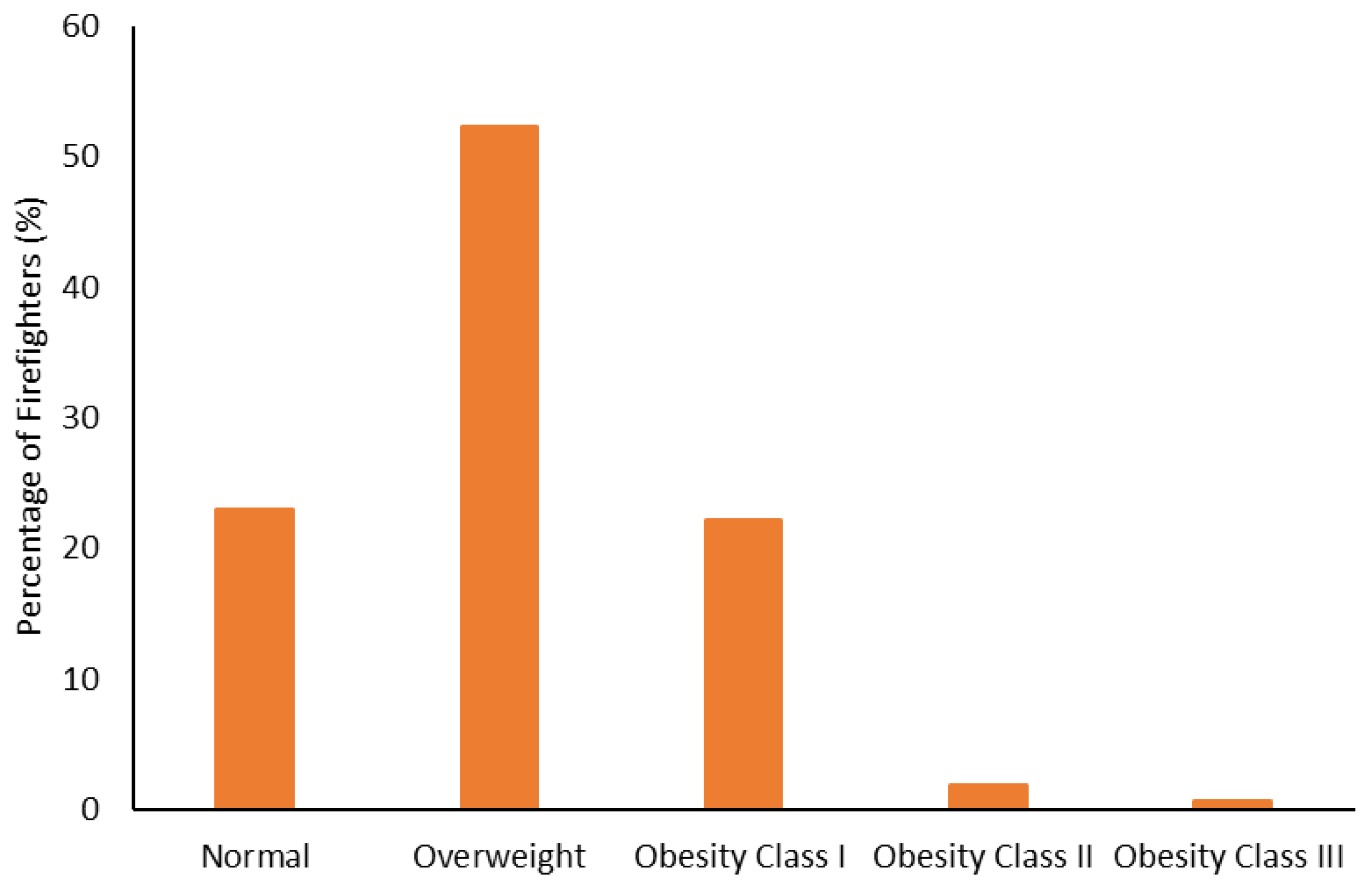
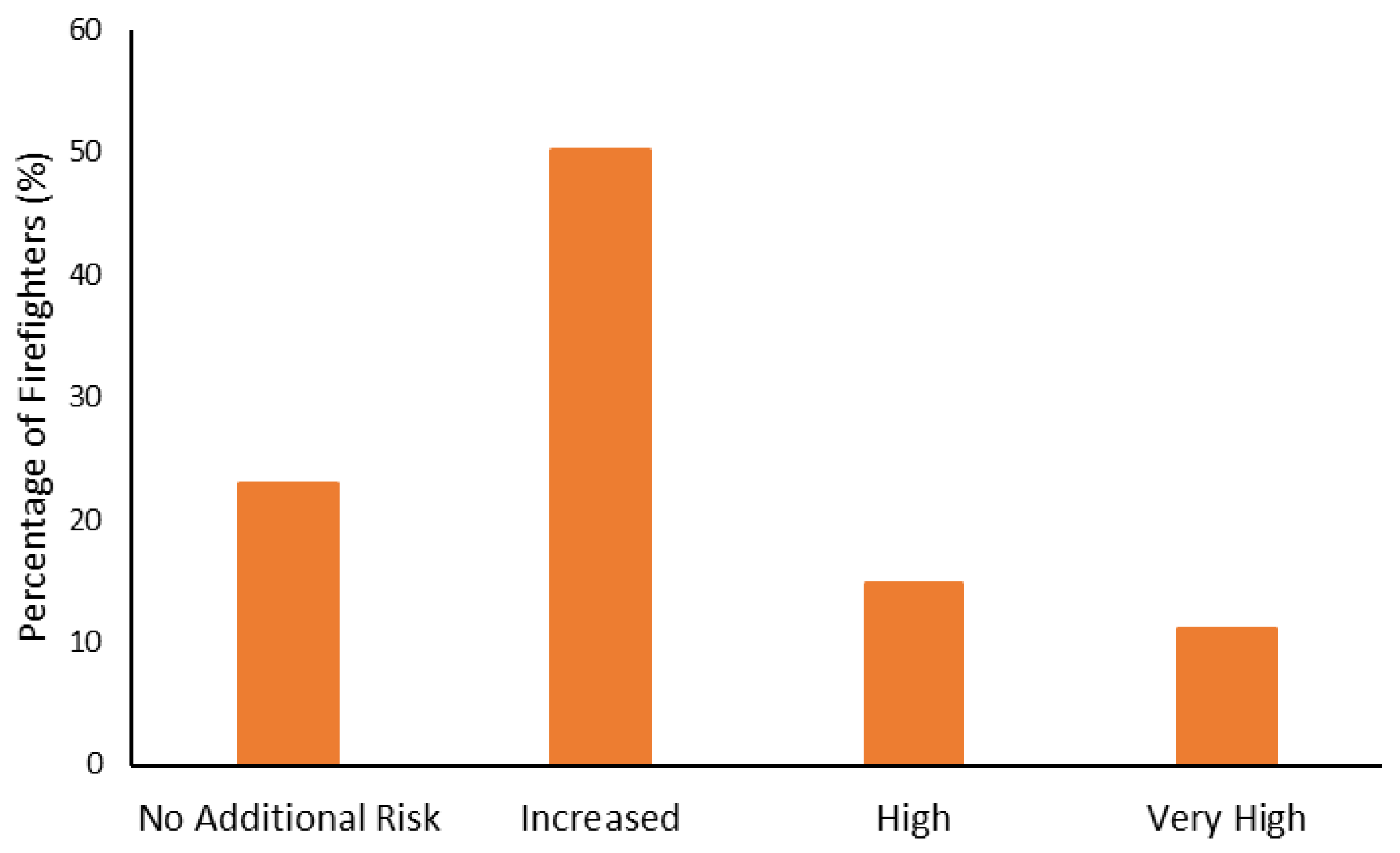
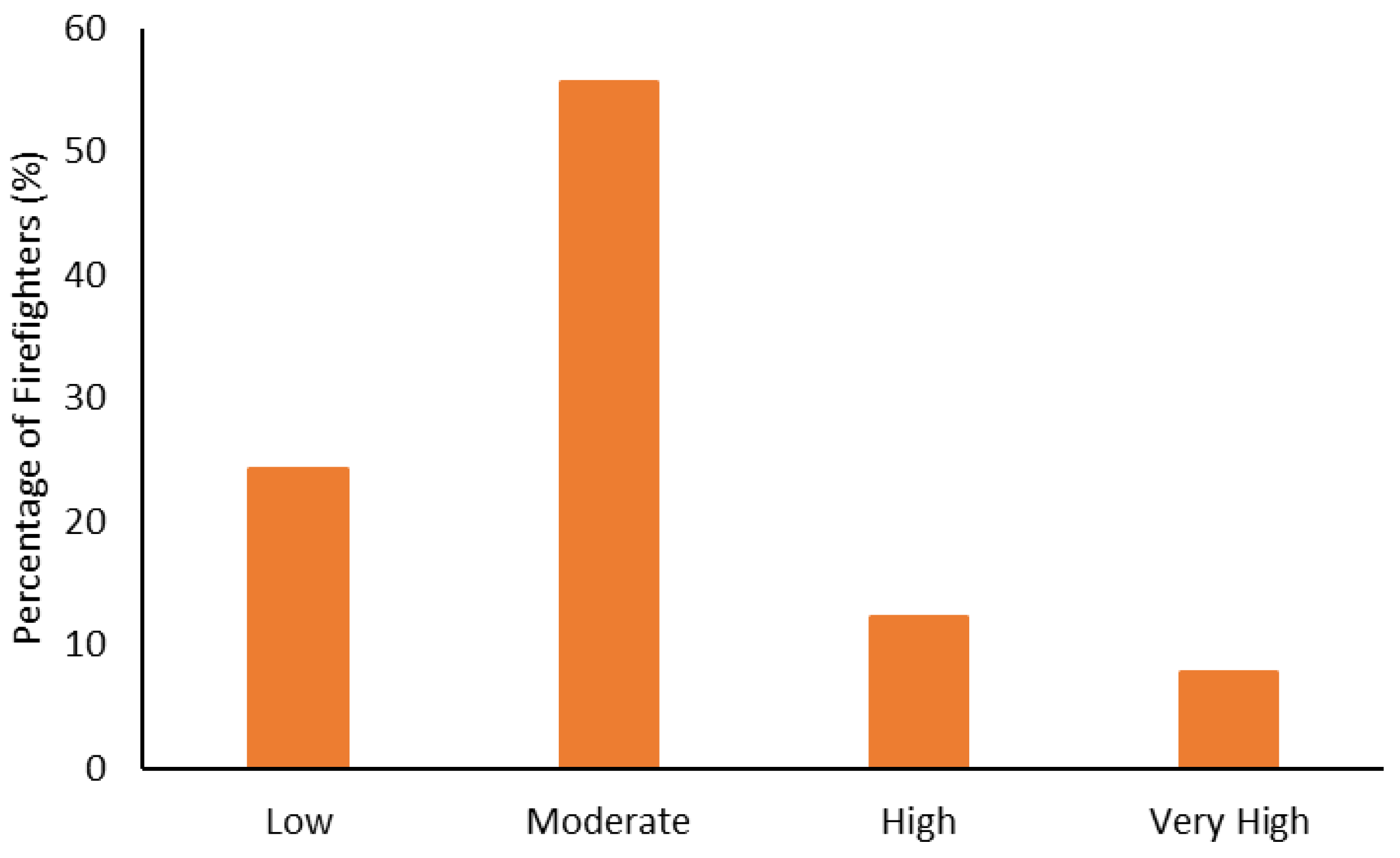
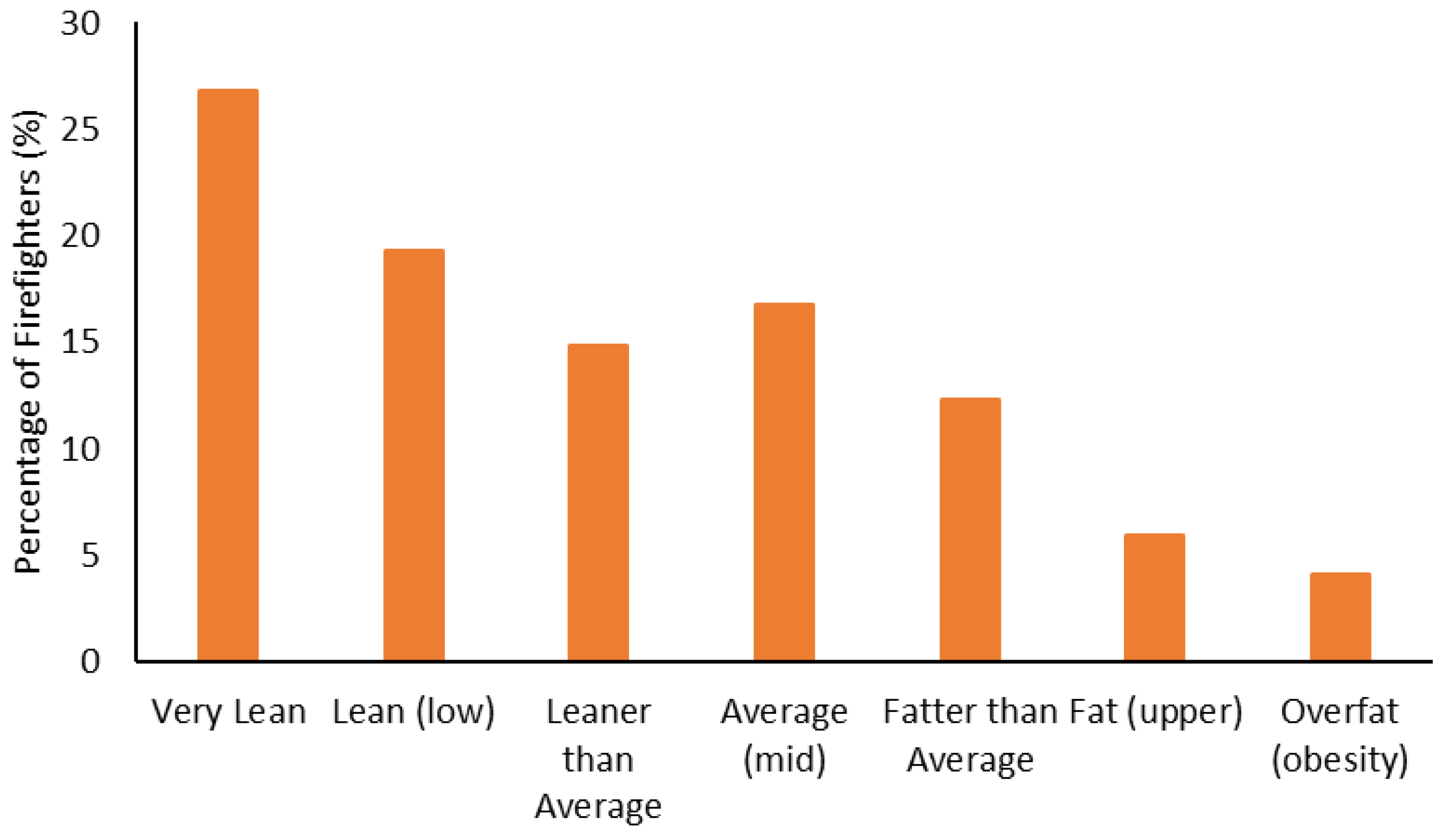

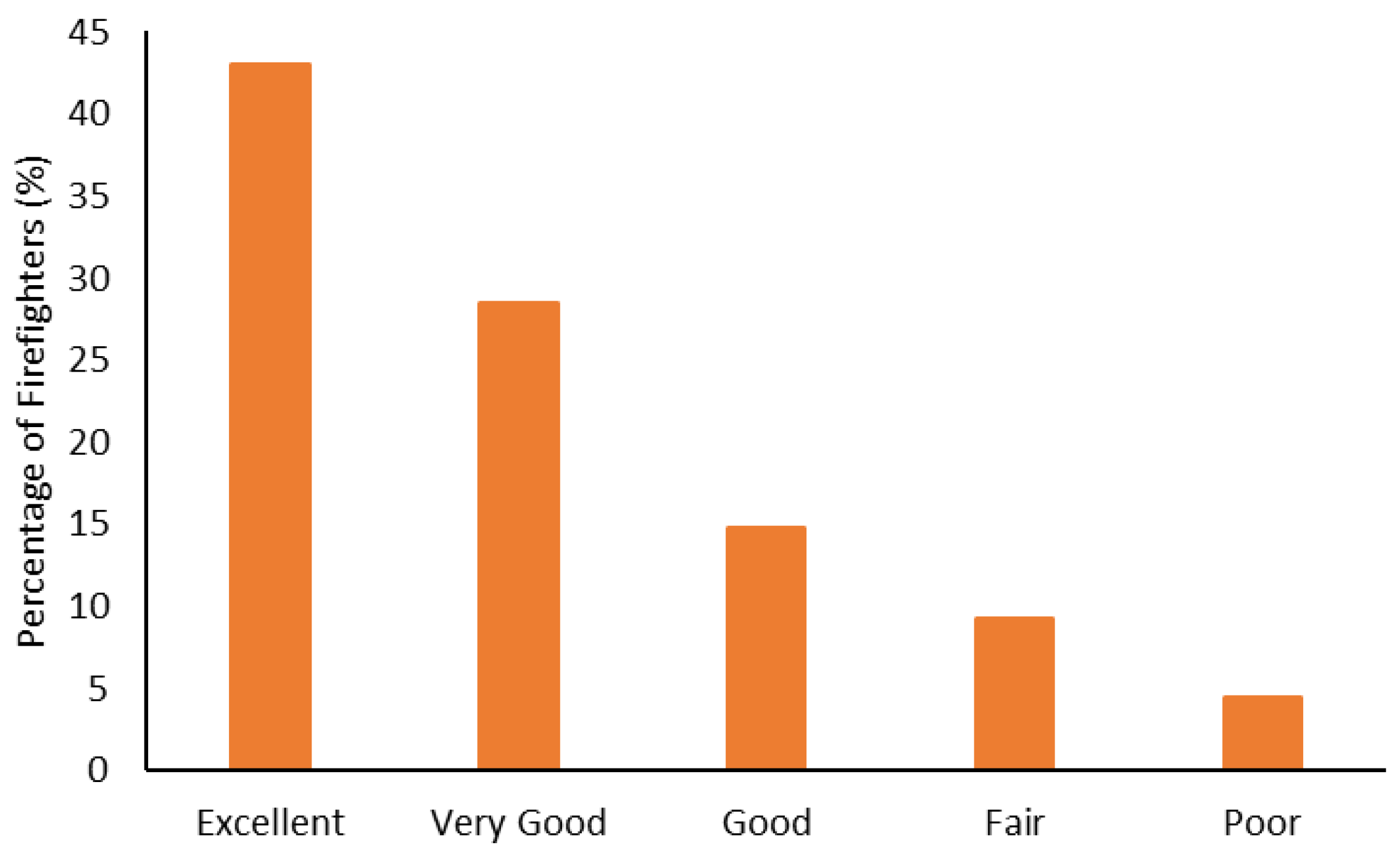
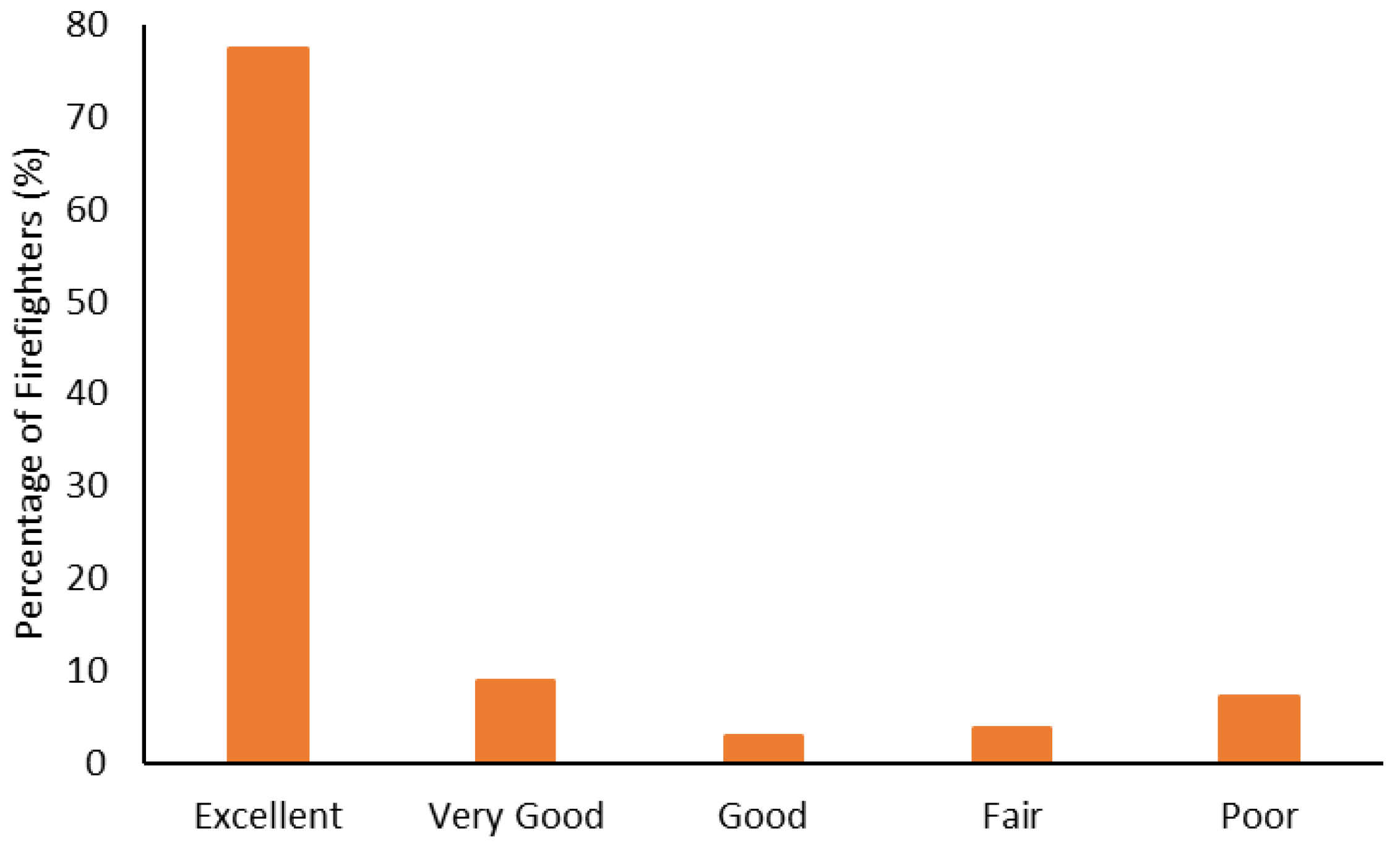
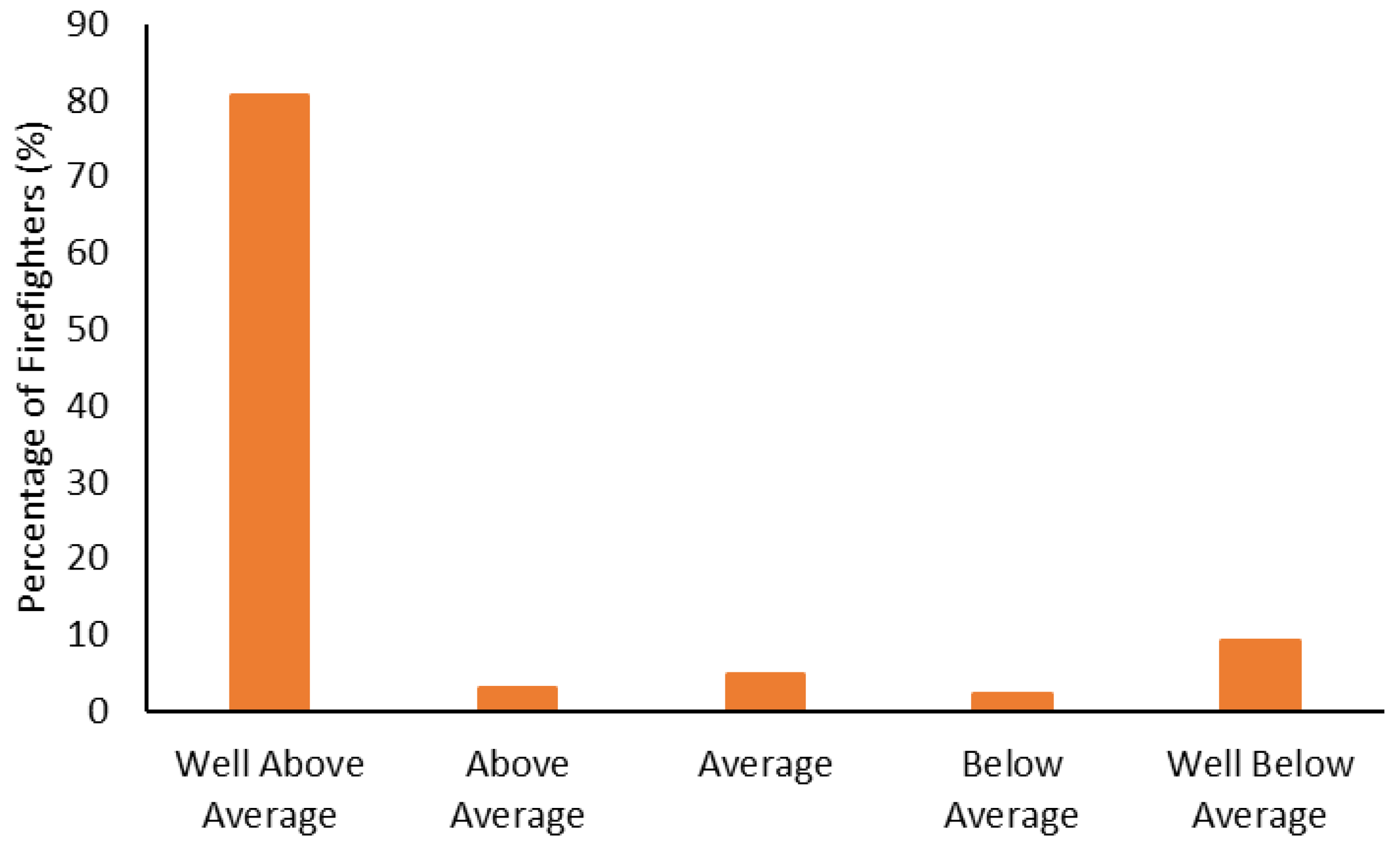
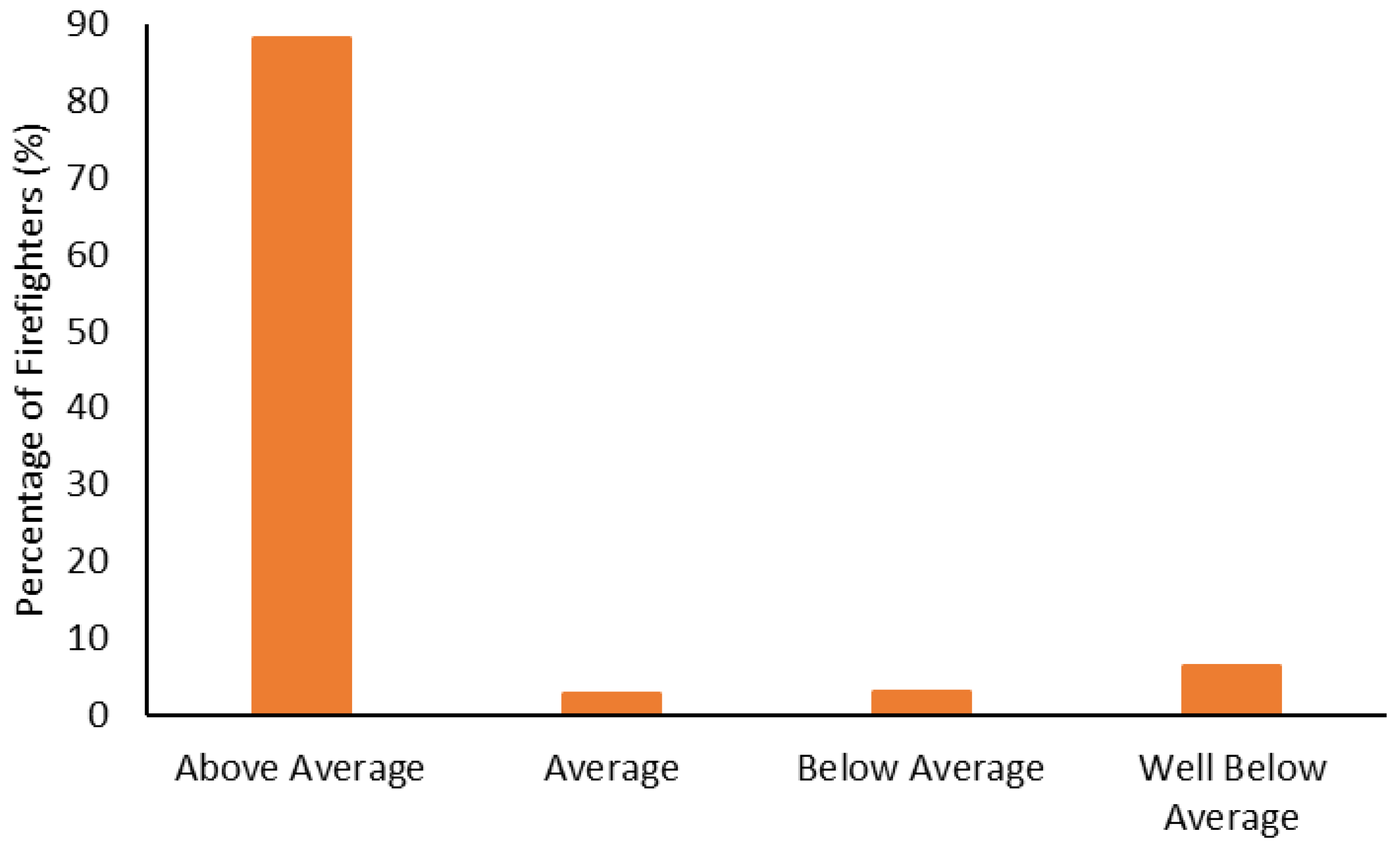

| Stage | Time (min) | Speed (km/h) | Grade (%) |
|---|---|---|---|
| 1 | 0–3 | 2.7 | 10% |
| 2 | 3–6 | 4.0 | 12% |
| 3 | 6–9 | 5.5 | 14% |
| 4 | 9–12 | 6.8 | 16% |
| 5 | 12–15 | 8.0 | 18% |
| 6 | 15–18 | 8.9 | 20% |
| 7 | 18–21 | 9.7 | 22% |
| Treadmill Time (min) | V̇O2max (mL/kg/min) |
|---|---|
| 5 | 17.7 |
| 6 | 20.2 |
| 7 | 23.1 |
| 8 | 26.5 |
| 9 | 30.2 |
| 10 | 34.1 |
| 11 | 38.2 |
| 12 | 42.5 |
| 13 | 46.7 |
| 14 | 51.0 |
| 15 | 55.1 |
| 16 | 59.0 |
| 17 | 62.7 |
| 18 | 66.1 |
| 19 | 69.1 |
| 20 | 71.6 |
| 21 | 73.6 |
| Tests | Combined (N = 270) | Males (n = 258) | Females (n = 12) | p |
|---|---|---|---|---|
| Age (years) | 42.27 ± 9.63 | 42.45 ± 9.51 | 38.42 ± 11.72 | 0.135 |
| Height (m) | 1.80 ± 0.07 | 1.80 ± 0.07 | 1.73 ± 0.07 * | 0.002 |
| Body Mass (kg) | 90.08 ± 13.13 | 90.61 ± 12.97 | 78.45 ± 11.47 * | 0.002 |
| Body Mass Index (kg/m2) | 27.87 ± 3.51 | 27.94 ± 3.43 | 26.24 ± 4.94 * | 0.027 |
| Body Fat Percentage (%) | 18.79 ± 6.12 | 18.68 ± 5.97 | 21.27 ± 8.69 * | 0.215 |
| Waist Circumference (cm) | 91.70 ± 9.64 | 92.25 ± 9.34 | 78.82 ± 7.37 * | <0.001 |
| Waist-to-Hip Ratio | 0.90 ± 0.07 | 0.90 ± 0.06 | 0.76 ± 0.05 * | <0.001 |
| Sit-and-Reach (cm) | 40.12 ± 9.88 | 39.67 ± 9.79 | 49.83 ± 6.37 * | <0.001 |
| Combined Grip Strength (kg) | 103.89 ± 15.61 | 104.98 ± 14.91 | 80.33 ± 11.58 * | <0.001 |
| 1 RM Leg Press (kg) | 370.39 ± 125.24 | 375.26 ± 124.99 | 265.69 ± 77.87 * | <0.001 |
| Crunches (repetitions) | 108.36 ± 45.78 | 107.94 ± 45.82 | 118.09 ± 45.79 | 0.108 |
| Push-ups (repetitions) | 38.00 ± 16.46 | 38.23 ± 16.62 | 32.45 ± 11.11 | 0.058 |
| Estimated V̇O2max (mL/kg/min) | 43.63 ± 8.78 | 43.74 ± 8.76 | 41.17 ± 9.25 | 0.328 |
| BMI | BF% | WC | WHR | ||
|---|---|---|---|---|---|
| Sit−and−Reach | r p | −0.143 * 0.021 | −0.220 * <0.001 | −0.249 * <0.001 | −0.196 * 0.001 |
| Grip Strength | r p | 0.075 0.222 | −0.177 * 0.004 | −0.007 0.911 | −0.151 * 0.014 |
| 1 RM Leg Press | r p | −0.219 * <0.001 | −0.389 * <0.001 | −0.358 * <0.001 | −0.305 * <0.001 |
| Crunches | r p | −0.291 * <0.001 | −0.383 * <0.001 | −0.369 * <0.001 | −0.289 * <0.001 |
| Push−ups | r p | −0.396 * <0.001 | −0.481 * <0.001 | −0.503 * <0.001 | −0.358 * <0.001 |
| Estimated V̇O2max | r p | −0.521 * <0.001 | −0.638 * <0.001 | −0.640 * <0.001 | −0.423 * <0.001 |
Publisher’s Note: MDPI stays neutral with regard to jurisdictional claims in published maps and institutional affiliations. |
© 2022 by the authors. Licensee MDPI, Basel, Switzerland. This article is an open access article distributed under the terms and conditions of the Creative Commons Attribution (CC BY) license (https://creativecommons.org/licenses/by/4.0/).
Share and Cite
Lockie, R.G.; Dulla, J.M.; Higuera, D.; Ross, K.A.; Orr, R.M.; Dawes, J.J.; Ruvalcaba, T.J. Body Composition and Fitness Characteristics of Firefighters Participating in a Health and Wellness Program: Relationships and Descriptive Data. Int. J. Environ. Res. Public Health 2022, 19, 15758. https://doi.org/10.3390/ijerph192315758
Lockie RG, Dulla JM, Higuera D, Ross KA, Orr RM, Dawes JJ, Ruvalcaba TJ. Body Composition and Fitness Characteristics of Firefighters Participating in a Health and Wellness Program: Relationships and Descriptive Data. International Journal of Environmental Research and Public Health. 2022; 19(23):15758. https://doi.org/10.3390/ijerph192315758
Chicago/Turabian StyleLockie, Robert G., Joseph M. Dulla, Daniel Higuera, Kristina A. Ross, Robin M. Orr, J. Jay Dawes, and Tomas J. Ruvalcaba. 2022. "Body Composition and Fitness Characteristics of Firefighters Participating in a Health and Wellness Program: Relationships and Descriptive Data" International Journal of Environmental Research and Public Health 19, no. 23: 15758. https://doi.org/10.3390/ijerph192315758
APA StyleLockie, R. G., Dulla, J. M., Higuera, D., Ross, K. A., Orr, R. M., Dawes, J. J., & Ruvalcaba, T. J. (2022). Body Composition and Fitness Characteristics of Firefighters Participating in a Health and Wellness Program: Relationships and Descriptive Data. International Journal of Environmental Research and Public Health, 19(23), 15758. https://doi.org/10.3390/ijerph192315758









